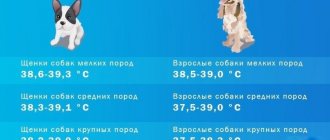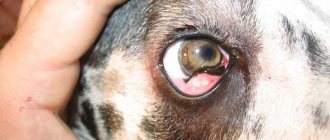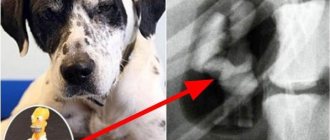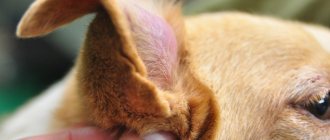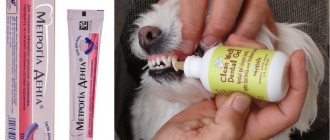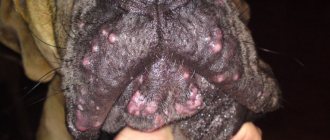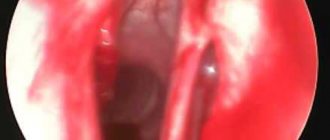May 19 2019
Off
Pathological childbirth usually occurs when the rules of mating are violated (prematurely before the onset of maturity of the body, with a large male), feeding and keeping (without exercise) whelping bitches, due to overdevelopment of the fetuses (if there are few of them), as well as due to the weakness of the birth forces.
After the examination, the bitches begin to collect an anamnesis, during which they find out the date of the last mating, the breed of the dog, the nature of feeding and maintenance, the beginning of whelping and how many fetuses and placenta were produced.
If 6 hours have passed since the start of pushing, and the presenting fetus has not come out, then help is usually required.
The examination of a woman in labor should begin with an examination, which allows us to assess the general condition of the bitch, the degree of enlargement and sagging of the abdomen, swelling of the mammary glands, the presence and nature of discharge from the genital slit. Greenish discharge is a sign of premature placental abruption and possible fetal death, while dirty-brown discharge with an unpleasant odor is a sign of the death of all fetuses. Before the examination, the dog is muzzled or the jaws are tied with a bandage. By measuring body temperature, determining the pulse rate and breathing, the condition of the woman in labor is clarified. An increase in body temperature above 39.5°C can be caused by infection of the uterus, necrosis of the maternal part of the placenta, uterine rupture and the development of peritonitis.
By palpation of the uterus through the abdominal walls, the presence of fetuses or placenta in the uterus is determined, and after childbirth, the degree of involution, possible accumulation of lochia or exudate. To carry out palpation, it is sometimes advisable to raise the front part of the body.
Ultrasound diagnostics makes it possible to determine the presence or absence of fetuses in the uterus, their number, size, position, as well as the condition of the bone base of the pelvis.
Before vaginal examination, the external genitalia, root of the tail, croup and perineum should be washed with warm water and soap, and treated with a 0.1% solution of potassium permanganate or furatsilin 1:5000. The tail is bandaged and pulled to the side, fixing it to the neck.
The obstetrician cuts the nails short, then the hands for 5 minutes. washes with hot water and soap or a 0.5% solution of ammonia and wipes with 0.1% iodized alcohol.
An index finger inserted into the vagina examines the condition of the birth canal. If it turns out that the cervix is slightly open, the membranes have entered the vagina, and there are no deviations from the bony base of the pelvis and the soft birth canal, then the bitch should be left alone. It is impossible to forcefully remove the fetus prematurely, as this can injure the birth canal.
If the birth canal is dry, the mucous membrane is lubricated with sterile petroleum jelly or petroleum jelly is injected using a rubber catheter and syringe.
You can speed up the removal of a fetus that is retained in the vagina by gently pulling on the head and legs in case of cephalic presentation and on the pelvic limbs and tail in case of breech presentation. It is more convenient to grasp the presenting parts of the fetus through a gauze pad or towel. The fetus should be extracted with moderate force, slowly, during contractions and pushing, making alternating movements to the right and left and in accordance with the arcuate direction of the pelvic axis. Do not pull too hard on the head due to possible damage to the spinal cord. Help is especially appropriate for breech presentation, since the fetus may die from asphyxia due to prolonged compression of the umbilical cord.
For the provision of obstetric care, the obstetric loop fixator has proven itself in practice. The retainer is sterilized by boiling, the end with the loop is treated with streptocide or synthomycin emulsion and inserted into the birth canal with minimal release of the cable loop. Pressing the handle of the rod with your left hand, spread the loop and grab the fetal head. If, when inserting a loop, the fetus moves deeper into the uterus, it is necessary to lift the front part of the woman in labor and push it into the loop with your hand through the abdominal wall. Then the fruit is removed.
Help for newborn puppies is needed only in cases where the bitch has a weak maternal instinct, and she does not gnaw the umbilical cord, does not free the newborn from the membranes and does not lick it. In this case, you need to quickly rupture or cut the membranes in the puppy’s head area, remove mucus from the nasal openings and oral cavity, otherwise he may die from asphyxia. After this, the umbilical cord is tied with a thread soaked in an alcohol solution of iodine to the thickness of a finger from the abdominal wall and crossed below the ligature. The puppy is wiped with a napkin or towel and massaged.
In case of asphyxia or difficulty breathing, pick up the puppy, securely fix the head, and shake it with a sharp downward movement. This helps clear the airways of mucus. You can cause the puppy's first squeak by lightly squeezing the head from the sides in the jaw area, briefly holding the puppy by the pelvic limbs, or irrigating the back of the head with a stream of cold water, followed by repeated massage and rubbing the body with a dry towel.
Insufficient contractions and pushing in dogs
Weakness of contractions and pushing is a consequence of insufficient intensity of contractions of the uterine muscles and abdominal muscles. Insufficient labor forces can manifest themselves in the form of primary and secondary weak contractions and pushing.
Primary weakness of labor is detected from the very beginning of labor, c. As a result, the fruits are not expelled. It is a consequence of poor feeding and lack of exercise of the bitch during whelping. The contractility of the uterine muscles can be weakened due to degenerative changes in the myometrium due to endometritis, as well as with excessive stretching due to the presence of a very large number of fetuses in the uterus. With primary weakness of contractions, the cervix opens extremely insufficiently, which leads to fetal retention and death, followed by putrefactive decomposition. In this case, the bitch may die from sepsis.
Secondary weakness of labor forces is a consequence of overwork of the muscles of the uterus and abdominal muscles, due to the incorrect positioning of the fetuses, the extremely large size of the fetuses, the narrowness of the birth canal, a large number of fetuses, the expulsion of some of which depletes the energy supply of the uterine muscles. Secondary weakness of contractions and pushing is easily recognized, since it is observed after the expulsion of one or more fetuses. In order not to mistake a break in labor for its end, it is necessary to palpate the uterus through the abdominal walls.
Help for bitches with primary weakness of labor should be limited to stimulating contractions of the uterine muscles. This is achieved by gently massaging the uterus through the abdominal walls, as well as “squeezing” the fetus by bandaging the abdomen with a wide towel in the direction from the diaphragm to the pelvis.
To enhance uterine contractions, pituitrin or oxytocin can be applied under the skin in a dose of 0.3-1.0 ml (1 ml - 10 units) depending on the animal’s body weight, but only when the cervix is open and at the stage of fetal expulsion. If the cervix is closed and there is a significant discrepancy between the pelvis and the size of the fetus, uterine rupture may occur. With secondary weakness of contractions and pushing, you must first establish and eliminate the cause, and then extract the fetus.
In the case of complete atony of the uterus and the absence of mechanical obstacles to childbirth, the only treatment option is a cesarean section.
What is estrus in dogs?
In veterinary medicine, the process of estrus is scientifically called estrus. This is a natural physiological process that indicates the dog’s readiness to procreate. During this time, owners may notice changes in the dog's behavior and preferences.
Before we look at when a dog goes into heat after giving birth, let's look at the signs of heat.
Narrow birth canal in dogs
The narrowing of the birth canal may be due to the narrowness of the pelvis, cervix, vagina, or genital opening.
Pelvic narrowness can be physiological (in young bitches who have not reached body maturity), congenital (underdeveloped, asymmetrical or rickets pelvis) and acquired (periostitis) due to fractures and cracks in the pelvic bones. Pelvic narrowness can cause obstruction of the fetuses, despite their normal size and position.
If attempts to extract the fetus with forceps, hooks or an obstetric loop are unsuccessful, a cesarean section is necessary.
Narrowing of the cervix can occur in the form of slow dilation and the impossibility of dilating. Slow dilation of the cervix is possible due to insufficient infiltration of the muscle layers of this part of the female reproductive system.
The inability to dilate the cervix may be due to strong cicatricial contraction of tissue due to a former wound (instrument) or strong tension of the fetus during assistance, which caused rupture of cervical tissue. Narrowing of the cervix is caused by neoplasms, adhesions, deposition of calcareous salts in tissues, and proliferation of connective tissue due to chronic cervicitis.
If the dilation of the cervix is delayed due to insufficient infiltration, one should take a wait-and-see approach, since in bitches, after 10-12 hours, the cervical canal can dilate completely and expulsion of the fetuses will occur. To open the cervix as quickly as possible, warm compresses are applied to the sacrum; ointment from belladonna extract 1:4 is applied topically, which is rubbed into the cervix. Sinestrol is injected intramuscularly at a dose of 1 ml of oil solution per injection. If waiting or using medications is unsuccessful, a caesarean section is resorted to.
Narrowing of the vagina can be primary (in primigravidas) and secondary (due to injuries and neoplasms on the vaginal wall). The greatest narrowing is observed at the point of transition of the vagina itself into the vestibule, since here the tissue has a denser consistency and, therefore, less elasticity. The narrowing of the vagina can be so significant that during childbirth, despite the presence of normal contractions and pushing, the fetus is not visible from the birth canal. By performing a vaginal examination with a finger, it is easy to detect the place of narrowing, and behind it you can feel parts of the fetus. To improve the sliding of the birth canal, vegetable oil, a decoction of flaxseed or a soap solution are injected into the vagina. Then they try to extract the fetus by placing an obstetric loop or forceps on the presenting parts of the fetus. If such attempts are unsuccessful, proceed to a caesarean section.
The narrowness of the genital fissure can be congenital or due to compression after wounds, removal of tumors, opening of abscesses, ruptures during previous births, and ulcerations. During whelping, with normal pushing, only the tips of the paws, the muzzle and part of the bladder protrude from the genital slit. The more voluminous parts of the fetus, resting against the perineum, protrude it.
Treatment consists of lubricating the mucous membrane of the vaginal vestibule with sterile Vaseline and removing the fetus after applying an obstetric loop or forceps. If this does not give a positive result and rupture of the perineum is inevitable, it is dissected. The surgical technique consists of dissecting all tissues along the suture line of the perineum.
How is childbirth?
Having seen that the dog is beginning to give birth - the waters have broken, the owner needs to place the pet in a prepared place and not leave it. An inexperienced owner who does not know how the waters break before giving birth in dogs may try to pierce the amniotic sac, which is absolutely unacceptable.
Before the birth process, the animal prefers to lie on its right side. During the first stage of labor, contractions become more frequent, as evidenced by the condition of the abdomen (the uterus tenses and relaxes). Contractions of the uterus ensure that the puppy moves through the birth canal to the cervix.
When asking questions: how to determine that labor has begun, how the dog’s birth proceeds, it is worth paying attention to the second stage of this process. It is characterized by the appearance of attempts - spasmodic movements that promote simultaneous contraction of the muscles of the diaphragm and abdominal cavity. At the moment of expulsion of the fetus, the bitch is able to lie on her side, on her chest or sit down.
The puppy may emerge from the “loop” with its muzzle or hind legs forward, enclosed in the amniotic sac. In most cases, the bitch herself will try to chew the shell to free the newborn.
The owner, who has information on how to deliver a dog’s birth and, if necessary, provide first aid, will need to burst the bladder himself if the animal has not done so.
A baby covered in blood and greenish mucus needs to clean his nose and mouth to clear the airways.
It is quite possible that the owner will have to cut or cut the puppy's umbilical cord. To carry out this procedure, the blood in the umbilical cord should be driven towards the newborn. You will need to clamp the umbilical cord with one hand at a distance of 3 cm from the baby’s abdomen, and with the other - slightly lower by 2-3 cm.
Next, the umbilical cord is broken, performed with the hand located closer to the puppy, which avoids the appearance of blood. You can also use scissors. If there is blood on the umbilical cord, you need to bandage it using a disinfected silk thread.
A healthy birth in dogs is accompanied by the delivery of the placenta after the birth of each puppy. You will definitely need to count the afterbirth that comes out. Their number should match the number of kids. Otherwise, it is worth contacting a veterinarian to examine the dog in order to prevent serious inflammation of its uterus due to a failed placenta.
Babies born after clearing the amniotic sac or breaking the umbilical cord must be transferred to a bitch. She will begin to lick the newborns, pushing them to stimulate blood circulation and respiratory processes. It is very important to quickly bring babies to the nipples. The sucking process stimulates more intense contractions of the uterus.
The first sips of colostrum contribute to the separation of original feces (meconium) in newborns, which in turn gives impetus to the launch of digestive processes. A weak puppy needs to massage its tummy and anus with a damp cotton swab.
If you are interested in the answer to the question: how many hours does it take for a dog to give birth, you need to know that the average duration of this process is 6 - 8 hours. Also, the duration of labor is influenced by the individual characteristics of each animal. Sometimes labor can be rapid, and sometimes it drags on for a day or more. Since a long labor can exhaust a bitch, you can offer her a piece of chocolate. Such a treat will help the animal regain its strength.
Large fetus and fetal deformities in dogs
Overdeveloped fetuses usually develop as a result of females mating with larger males, as well as when there are only one or two fetuses in the uterus. Established as large by examining the vagina with a finger and palpating the uterus through the abdominal wall
Whelping with overdeveloped fetuses in a bitch is extremely difficult, since the bitch has a long crotch and a relatively narrow vulva. Therefore, the perineum during childbirth is an obstacle to the exit of the fetus and the latter must advance not in a straight line, but in an arched manner. As a result, the bitch experiences severe pain, becomes overtired and weak. Obstetric care here is perineotomy or dissection of the perineum.
With a cephalic proposal, the fetal head is shown in the birth canal; with a pelvic proposal, the hind limbs are shown. After this, grasping with three fingers, using light pulling and making semicircular movements, we remove the head. At the same time, we carefully but confidently press on the abdominal wall towards the pelvis. Thus, the fetus is pulled up and squeezed out. After the first fetus is removed, the bitch should rest from labor pains. Then the head or pelvic limbs of the next fetus will appear in the birth canal. The fruits must be extracted gradually at intervals of 15 to 30 minutes.
Wire and twisted obstetric loop: A - prepared loop; B - applied to the fetal neck.
To facilitate the work of obstetric care, the following tools are used, the most tested and proven in practice. When extracting large fruits from bitches, the most convenient are loops made from a brass tube and a soft (preferably copper) double wire inserted into its lumen, so that a loop is formed at one end of the tube. The loop is advanced from the side of the fetal head and then tightened.
Several options for pliers have been proposed, but none of them can be considered universal due to the large difference in the size of the branches. The forceps are inserted closed to the fetal head, opened and, grasping the head, compressed, after which the fetus is removed. If, when squeezed with forceps, the fetus moves deeper into the uterus, then you need to feel it with your hand through the abdominal wall and, after moving it a little, insert it into the open forceps. In bitches you can achieve good results using durable forceps, fenestrated tweezers, and tongs. The listed instruments must be used carefully, under the control of your finger, so as not to pinch the wall of the birth canal.
Hooks are also used, 40-45 cm long and 0.5 cm thick. The value of these hooks lies in the fact that, by grabbing the handle with your hand, you can follow the position of the handle in the direction of the hook located in the birth canal of the animal. This prevents tissue damage during operation.
If the fetus cannot be extracted, then it is better to resort to a caesarean section. In case of deformities, the fetus should also be removed by caesarean section.
Features of maintenance and care
Since estrus before and after birth is no different, there are general rules for caring for dogs during this time.
So, when a dog goes into heat after giving birth, it is necessary to mark the beginning and end of it. This is recommended to be done from the moment of the female's first heat. This way you can track the moments of estrus and be ready for the next heat.
If you are not yet planning to breed your bitch, then when walking you need to keep her on a leash at all times. And also be very careful and not let male dogs get close to her. If you lose sight of this moment and the mating process begins, it will be very difficult to interrupt it and pull the male away. In addition, this can be dangerous, since many animals become aggressive during estrus and they may simply not like the fact that you decided to interfere with them.
During estrus, it is not recommended to allow the female to swim in bodies of water, as this risks causing her to contract an infection. It is better to limit these procedures for a while, even if the animal is hot. You can wet your nose, back of your ears, and paw pads with clean water.
Special underwear is provided for dogs in heat. It is a seamless panty with a hole for a tail. However, many veterinarians are against this device. They believe that a dog should lick itself during heat. Bloody discharge from the loop at this time is a physiological norm, and panties were invented to make life easier for the owners.
However, if you are still going to put them on your dog, then you need to keep in mind that they must be made of natural fabric and fit exactly in size. If these conditions are not met, then you risk harming the female’s health.
Abnormal articulation and fetal position in dogs
Turning the head to the side. Only underdeveloped puppies can be removed without correcting the position of the head. Correcting the position of the head using a hook inserted into the eye socket or ear canal, or a forceps, is possible only in large bitches. In small breed dogs, caesarean section is indicated.
Lowering the fetal head down. In this case, you can try to remove the head by pressing on the skull with a finger inserted into the vagina, while simultaneously pressing with the other hand on the abdominal wall. If the fetus is small, then you can bring the head into the birth canal with a hook attached to the bend of the neck without first straightening the head. If the result is negative, a caesarean section is resorted to.
Throwing back of the fetal head. This malposition of the fetal head is rare in bitches. In this case, the hook is inserted into the chest and abdominal cavities of the fetus and the walls are torn with it. This reduces the volume of the body, as the internal organs fall out. Then the hook is placed behind the bend of the neck and the fruit is removed. In bitches of small and dwarf breeds, without wasting time, they proceed to a caesarean section.
Flexion of the joints of the thoracic limbs. In puppies, flexion of the elbow and shoulder joints is considered a physiological phenomenon, since during normal labor the fetuses are expelled from the uterus. When bending the limbs at the wrist joints, blunt hooks are used or the limbs are pushed as far into the uterus as possible, after which forceps are applied to the head and the puppy is removed out.
Flexion of the joints of the pelvic limbs. If the limbs are bent at the hock joints, you can use blunt hooks that are placed above these joints. In females of large and medium breeds, this malposition of the limbs can usually be easily corrected. In bitches of dwarf breeds, the fetus is removed using forceps placed on the fetal pelvis, without first correcting the limbs bent at the hock joints.
When the limbs are flexed at the hip joints, the fetus can be removed without correction using hooks.
The position of the fetus is considered correct when the longitudinal axes of the fetus and the birth canal coincide. But sometimes variants of incorrect position are observed.
Transverse position with abdominal presentation. In this case, the fetus lies transversely, and all four limbs are directed into the birth canal. The fruits of bitches rarely take the classic transverse position. Presentation is often thoracic when the head is positioned in the other horn. In large breed bitches, the front part of the fetal body should be straightened and then the fetus should be removed. In bitches of medium and small breeds, the fetus can only be extracted by caesarean section.
Transverse position with dorsal presentation. In this case, the fetus lies with its back to the exit of the birth canal. With a finger inserted into the birth canal, you can feel the spinous processes of the fetal spine. In such cases, it is usually possible to extract the fetus only by performing a caesarean section.
Simultaneous entry of two fetuses into the birth canal. During normal whelping, the fetuses are expelled from the uterus sequentially (one after the other). But sometimes two fetuses become wedged into the birth canal. With this anomaly, four pelvic limbs, two pelvic and two thoracic, a head and two pelvic limbs may be shown. By palpation through the abdominal walls, one can detect the entry of two fetuses into the birth canal.
Sometimes, before entering the pelvis, adhesion (collision) of the fruits may occur. This happens when the fetuses enter almost simultaneously, with the first of them being in the breech presentation, and the second in the cephalic presentation. Providing assistance with the simultaneous entry of two fetuses into the birth canal consists of applying a forceps or bullet forceps to the presenting parts of one fetus and pushing away the other fetus with a finger inserted into the vagina. With the other hand, it is simultaneously necessary to help push the fetus through the abdominal walls towards the mother’s chest.
When clutching fetuses, it is necessary to pull back the fetus coming from behind and at the same time push away the fetus that has partially emerged from the birth canal. After separation of the fruits, the first one is removed, and the second one usually comes out without assistance.
Preparing for the birth of a dog
In most cases, pregnancy in bitches lasts 59 - 63 days. Based on the mating date, owners will be able to calculate the timing of their dogs’ births in order to have time to prepare for a significant event in advance.
Having determined the due date for dogs of small breeds (medium, large), many owners of four-legged pets try to arrange for a veterinarian to come to your home 2-3 weeks in advance. As a rule, when a dog gives birth for the first time, the presence of a specialist is extremely desirable, since the owner himself does not have the necessary experience to provide the necessary assistance to the animal. Read the article: How long does a dog’s pregnancy last and how does it progress day by day?
Setting up a place for the bitch and puppies
1.5 weeks before the due date, it is advisable to start organizing the place where the bitch will give birth. The use of a collapsible playpen (a spacious box), in which the animal can lie freely during childbirth, has proven itself to be effective. This is where the dog will eventually settle down with the puppies.
Experienced dog handlers recommend providing a small space between the bottom of the arena and the floor to prevent the dog and babies from freezing. It is necessary to ensure that the arena (box) has one of the walls with a lower height, which allows the bitch to leave the “nest”, but does not allow the puppies to get out of there.
Dog breeders practice giving birth to dogs on a sofa or bed. This decision is completely justified, especially when it comes to the birth of a representative of a large breed. In such cases, you will need to cover the surface of the furniture with oilcloth or a clean sheet.
Since the birth process is quite dirty, it is highly advisable to remove carpets and rugs from the room. In addition, for this procedure it is worth using bedding, which will later be thrown away.
List of things, tools, medicines
In preparation for giving birth to a dog, it is necessary to acquire a “midwifery kit”. It should include:
- a large oilcloth, an old sheet - these items will be placed under the animal;
- heating pad;
- a basin for dirty rags;
- regular, room, veterinary thermometers;
- a cardboard shoe box in which newborn puppies will be placed;
- tray for medical instruments that have been sterilized;
- tweezers, syringes, scissors;
- cotton wool, sterile gauze wipes;
- sterile silk threads, with which the umbilical cords of babies will be tied;
- scales;
- a set of woolen multi-colored threads for marking puppies;
- a pen, a dog’s birth diary, a watch for recording the time of birth of puppies, a description of the process;
- chocolate bar
The list of medications includes:
- medical alcohol or vodka;
- glucose 5% in ampoules;
- synthomycin emulsion 10%;
- hydrogen peroxide;
- brilliant green (brilliant green solution).
Preparing the dog
A day before giving birth, the owner will need to wash the bitch’s belly, genitals, and trim her hair in the area of the belly, “loop,” and anus.
If the animal has long hair, it is advisable to collect the interfering strands with hair ties or curlers. The beard and mustache are often trimmed so that they do not interfere with biting the puppy’s umbilical cord (this procedure is recommended for the same terriers).
Host preparation
An owner who is interested in what is needed to give birth to a dog should also worry about cleanliness, disinfection of his hands, and cutting his nails short. You need to wear clean clothes that you won’t mind getting rid of after the birth is over.
Retention of placenta in dogs
Childbirth ends with the separation of the membranes (afterbirth). In bitches, during the normal course of labor, this separation should occur no later than two hours after the expulsion of the fetuses. If separation of the placenta does not occur within the specified period, we can speak of retention of the placenta.
Etiology. Retention of the placenta can be caused by weakness of the placenta contractions due to inadequate feeding and lack of walks (exercise) during whelping, which leads to uterine atony. The reasons for the retention of the placenta may be the fusion of the fetal placenta with the maternal placenta due to the presence of pathological processes in them, overdistension of the uterus by a large number of fetuses or large fetuses.
Symptoms and course. Retention of placenta in bitches is very dangerous compared to other types of animals, as it quickly becomes complicated by sepsis on the 2-3rd day. Although this pathology in bitches is recorded quite rarely.
This complication of childbirth is characterized by lack of appetite, lethargy, and increased body temperature. When examining through the abdominal walls, we find focal compaction or focal thickening of the uterine horn. Discharge from the genital slit has an unpleasant odor.
Forecast. If the placenta is not removed in a timely manner, puerperal sepsis will develop. Characteristic signs of this complication are: a rapid increase in body temperature, increased heart rate and breathing, an indifferent attitude towards the environment, vomiting, bloody diarrhea or constipation. The animal lies down, the cornea sometimes becomes dry and cloudy. Without timely medical assistance, the bitch dies from sepsis in the period from 6 to 60 hours.
Treatment of dogs. In order to remove the placenta, you can massage the uterus through the abdominal walls in the direction from the chest to the pelvis. No later than two hours from the moment of expulsion of the last fetus, it is recommended to use pituitrin or oxytocin subcutaneously or intramuscularly at a dose of 2.5-15 units.
In most unadvanced cases, it is possible to separate the placenta by massaging the uterus through the abdominal walls or using pituitrin or oxytocin. If the placenta is delayed for more than 12 hours, then antibiotics are administered intramuscularly to prevent sepsis. In addition, calcium gluconate is administered intravenously or intramuscularly; intravenously or subcutaneously - glucose; Vitamins C and B12 are used. In case of rapid deterioration of the general condition and suspicion of the development of necrosis of the maternal part of the placenta, urgent hysterectomy is indicated.
Prevention. To prevent retention of the placenta during whelping, you should not tear off the umbilical cord after the puppy emerges. It is necessary to hold the newborn with one hand, and with the other to push the placenta through the abdominal wall, tearing it away from the mucous membrane of the uterus. It is easy to detect the place of attachment of the placenta by the stretched umbilical cord. And then the afterbirth will come out along with the puppy.
The final stage of labor in a dog
This stage is associated with the release of the placenta (baby placenta). The placenta usually comes out 15 minutes after the birth of the puppy, it often happens that 2-3 puppies are born and several places come out at once, this is considered the norm.
If the placenta looks natural and does not have any unpleasant odors, then the first 2-3 pieces can be given to the dog to eat, this is a natural way to enhance labor.
Giving the dog all the afterbirth is not recommended, as this can cause severe diarrhea, which will be unnecessary for the mother in labor.
Trauma to the birth canal in dogs
Ruptures of the soft tissues of the birth canal, especially the vagina and vulva, are observed more often in primiparous bitches due to their poor extensibility when extracting large (especially emphysematous) fetuses or due to inept use of obstetric instruments (forceps, hooks, etc.). Sometimes, mainly in bitches of decorative breeds with a pampered constitution (dachshund, lapdog, miniature Doberman pinscher, Spitz, etc.), when removing a large fetus, a rupture of the pubic symphysis or a fracture of the pelvic bones occurs.
Symptoms and course. Minor injuries to the vaginal mucosa usually go unnoticed, but significant ones are accompanied by severe bleeding and swelling. Particularly dangerous are penetrating vaginal ruptures, which are often complicated by phlegmon of the paravaginal tissue, peritonitis and sepsis. Moreover, already on the second day the animal’s condition worsens sharply, the body temperature rises significantly, and the bitch does not get up. If the pubic symphysis is ruptured or the pelvic bones are fractured, the animal cannot stand or lean on one limb. The perineum and vulva are swollen. By inserting a finger into the rectum and palpating the pubic bones from the outside, a fracture can be established. A more accurate diagnosis is provided by radiography.
The prognosis for ruptures of vaginal and vulvar tissue depends on the location and degree of damage. Penetrating wounds of the cranial part of the vagina are especially dangerous, since they can be accompanied by the development of peritonitis, sepsis or prolapse of intestinal loops. If the pubic fusion is ruptured, the prognosis is favorable with regard to recovery and questionable with regard to the possibility of subsequent births. For simple fractures of the ilium, the prognosis is questionable, and for intra-articular and displaced columnar fractures, the prognosis is unfavorable.
Treatment of dogs. Wounds of the vagina and vulva are treated with antiseptic emulsions and ointments (streptocidal, syntomycin, etc.), a course of antibiotics is given intramuscularly, biseptol (Bactrim) is given orally, 1-2 tablets 2-3 times a day, and symptomatic treatment is given. When the bones of the pubic symphysis diverge, rest and a tight circular bandage of the pelvis are necessary.
Complications during childbirth
Childbirth proceeding normally is still a difficult, exciting process for the animal. The occurrence of complications during the birth process can endanger the life of the dog and its litter.
If the bitch experiences: weak labor or its absence, premature loss of amniotic fluid, non-elasticity of the soft tissues of the birth canal, you should immediately call a veterinarian. In particular, complications during childbirth in small breed dogs can be caused by incorrect position of the fetus, its too large size, excessive narrowness of the pelvis, the presence of a dead puppy in the womb, and other factors.
Trying to alleviate the situation on your own is inappropriate. It would be much more correct to immediately seek emergency help from a specialist. The veterinarian will examine the animal and perform the necessary manipulations. This will save the life and health of the dog and its puppies.
Uterine rupture in dogs
Uterine ruptures in bitches and cats are not so rare. They can be complete, if the integrity of all layers of the uterus is violated, and incomplete, if two or one layer of the uterine wall remains intact. Breaks can be spontaneous (spontaneous) or artificial.
Etiology. Spontaneous ruptures are observed with excessively strong contractions and attempts during pathological labor caused by the narrowness of the birth canal, malposition or deformity of the fetus. Artificial ruptures are the result of rough and inept manipulations during obstetrics (pinching the uterine wall with forceps, piercing with an obstetric hook used to extract the fetus).
Symptoms and course. Incomplete uterine ruptures usually go unnoticed. With complete ruptures, there is a sudden cessation of pushing. Discharge of blood from the genital fissure is rarely recorded, since severe internal bleeding occurs, usually leading to acute anemia. In some cases, symptoms of peritoneal irritation, abdominal tenderness, vomiting, etc. appear. By palpation of the abdominal organs, one can establish excessively high mobility of the fetuses, which does not happen when they are located in the uterus.
Treatment of dogs. If timely assistance is provided, the prognosis is favorable. Treatment is surgical. The abdominal cavity is opened under local anesthesia (animals cannot tolerate anesthesia in these cases). Typically, the abdominal cavity contains fetuses along with placenta, amniotic fluid and blood. They are removed. Uterine rupture is often longitudinal. Small tears are sutured with catgut (as with a caesarean section). For large tears, an ovariohysterectomy is performed. The abdominal cavity is washed with a warm 0.1% solution of ethacridine lactate, after removal of which it is treated with syntomycin or streptomycin liniments. A course of antibiotic treatment is carried out for 3-5 days. In cases of acute anemia, special therapy is carried out.

